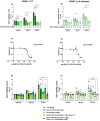NIR pH-Responsive PEGylated PLGA Nanoparticles as Effective Phototoxic Agents in Resistant PDAC Cells
- PMID: 40284366
- PMCID: PMC12030558
- DOI: 10.3390/polym17081101
NIR pH-Responsive PEGylated PLGA Nanoparticles as Effective Phototoxic Agents in Resistant PDAC Cells
Abstract
Pancreatic ductal adenocarcinoma (PDAC) is one of the deadliest cancers worldwide due to its resistance to conventional therapies that is attributed to its dense and acidic tumor microenvironment. Chemotherapy based on gemcitabine usually lacks efficacy due to poor drug penetration and the metabolic characteristics of the cells adapted to grow at a more acidic pHe, thus presenting a more aggressive phenotype. In this context, photodynamic therapy (PDT) offers a promising alternative since it generally does not suffer from the same patterns of cross-resistance observed with chemotherapy drugs. In the present work, a novel bromine-substituted heptamethine-cyanine dye (BrCY7) was synthesized, loaded into PEG-PLGA NPs, and tested on the pancreatic ductal adenocarcinoma cell line cultured under physiological (PANC-1 CT) and acidic (PANC-1 pH selected) conditions, which promotes the selection of a more aggressive phenotype. The cytotoxicity of BrCY7-PEG-PLGA is dose-dependent, with an IC50 of 2.15 µM in PANC-1 CT and 2.87 µM in PANC-1 pH selected. Notably, BrCY7-PEG-PLGA demonstrated a phototoxic effect against PANC-1 pH selected cells but not on PANC-1 CT, which makes these findings particularly relevant since PANC-1 pH selected cells are more resistant to gemcitabine as compared with PANC-1 CT cells.
Keywords: PEGylated PLGA nanoparticles; heptamethine-cyanine dyes; photodynamic therapy; resistant PDAC cells.
Conflict of interest statement
The authors declare no conflicts of interest.
Figures






Similar articles
-
Pseudopterosin and O-Methyltylophorinidine Suppress Cell Growth in a 3D Spheroid Co-Culture Model of Pancreatic Ductal Adenocarcinoma.Bioengineering (Basel). 2020 Jun 14;7(2):57. doi: 10.3390/bioengineering7020057. Bioengineering (Basel). 2020. PMID: 32545910 Free PMC article.
-
pH-Sensitive Nanodrug Carriers for Codelivery of ERK Inhibitor and Gemcitabine Enhance the Inhibition of Tumor Growth in Pancreatic Cancer.Mol Pharm. 2021 Jan 4;18(1):87-100. doi: 10.1021/acs.molpharmaceut.0c00499. Epub 2020 Nov 24. Mol Pharm. 2021. PMID: 33231464
-
Specific cellular internalization and pH-responsive behavior of doxorubicin loaded PLGA-PEG nanoparticles targeted with anti EGFRvIII antibody.Life Sci. 2020 Nov 15;261:118361. doi: 10.1016/j.lfs.2020.118361. Epub 2020 Aug 28. Life Sci. 2020. PMID: 32861796
-
Gemcitabine and rapamycin-loaded mixed polymeric thermogel for metastatic pancreatic cancer therapy.J Control Release. 2023 Aug;360:796-809. doi: 10.1016/j.jconrel.2023.07.010. Epub 2023 Jul 23. J Control Release. 2023. PMID: 37437850
-
Circular RNA Signature Predicts Gemcitabine Resistance of Pancreatic Ductal Adenocarcinoma.Front Pharmacol. 2018 Jun 5;9:584. doi: 10.3389/fphar.2018.00584. eCollection 2018. Front Pharmacol. 2018. PMID: 29922161 Free PMC article.
References
-
- Audero M.M., Carvalho T.M.A., Ruffinatti F.A., Loeck T., Yassine M., Chinigò G., Folcher A., Farfariello V., Amadori S., Vaghi C., et al. Acidic Growth Conditions Promote Epithelial-to-Mesenchymal Transition to Select More Aggressive PDAC Cell Phenotypes In Vitro. Cancers. 2023;15:2572. doi: 10.3390/cancers15092572. - DOI - PMC - PubMed
LinkOut - more resources
Full Text Sources
Miscellaneous

